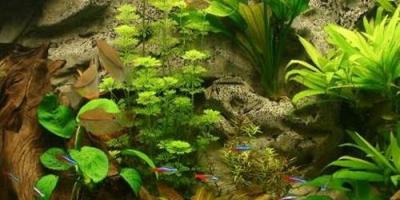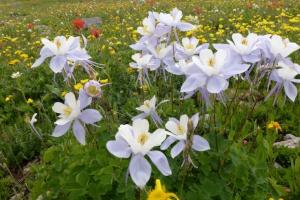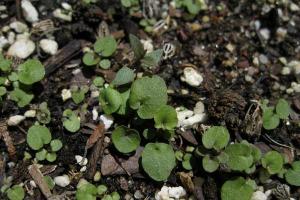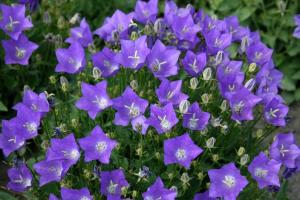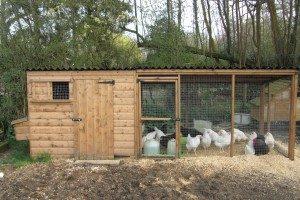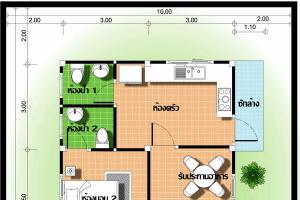Rezuha is a perennial evergreen. It blooms from April to June. Gardeners use only a small part of the varieties of rhizomes. All of them are capable of forming a flowering carpet and are characterized by lush growth.
Description of the plant
Rezuha (Arabis) belongs to the cruciferous family. Native to Asia or Europe. Translated from Greek arabos means "grinding". Some of its species have hard, small hairs on the leaves and stems that hurt the hands, which is why the plant was called rezuha.

This low perennial blooms early. It can reach up to 30 centimeters in height. The shape of the leaves is graceful, silver in color, and they have pubescence. The color of the petals ranges from whitish to pinkish. Terry varieties look very attractive.

Arabis blooms abundantly - from a distance the bush looks like a bright spot. In cool weather, Arabis blooms better - up to 8 weeks.

Features of varieties
Each variety of the genus “Rezuha” is unique and has its own characteristics.
- Rezuha Caucasian (Arabis caucasica) differs in pink and white flowers. Width – up to 60 centimeters, height – 25 centimeters.
- The most popular variety is Plena. It reaches a height of 25 centimeters.
- The Schneehaube variety is characterized by abundant flowering.
- It is worth paying attention to the red variety Coccinea and compact terry FlorePleno.
- Of the new species, it is worth highlighting LaFraicheur And Compinkie. Their flowering occurs in summer.
- Rezuha Arends is a hybrid. It is obtained through crossing Arabis aubrietoides And Arabis caucasica. Flower color is pink.
- Protruding recess has dark green leaves. Flowering occurs in April. The most popular variety Neuschnee.
- Variety Variegata has leaves edged with a white stripe.

Planting and care
Planting is carried out in autumn or spring period. First, the soil is loosened and compost is added. If the soil is heavy, it is lightened by adding sand. The soil should be well drained, the place should be sunny or slightly shaded.
Seedlings should be removed with extreme caution. The glass is turned upside down, then gently pressed so that the roots come out of the container.

During planting, roots should be untangled and shoots that are too long should be shortened. The distance between plants should reach 25 cm.

All Arabis varieties are unpretentious. Any soil suits them. As for the Caucasian Arabis (its image can be seen in the photo), it must be periodically rejuvenated, otherwise the central part of the plant will look unsightly, and flowering will shift to the periphery. After flowering, the shoots are shortened - they should be no more than 10 centimeters.
Rezukha: description (video)
- It is better to plant rhizomes in multi-colored groups over a large area.
- After the plant has flowered, you can begin dividing it. To do this, rosettes are plucked from the bush. They are placed in cups and taken to a slightly shaded place. In the spring it will be possible to plant in the ground.
- At the end of flowering, the rhizome is trimmed. A “cushion” should form.
- Caucasian Arabis can be planted in a hole made in black film, and then mulched with expanded clay or stones. This will prevent weeds from appearing. You can let the plant hang freely from the stone, but in this case you will have to trim it periodically.
- When seedlings appear, it is necessary to provide ventilation to the crop. To do this, glass is removed from the greenhouse. As soon as the seedlings grow up, they can be moved to the garden bed. Since flowers require low temperatures to appear, flowering will occur only after a year.

Despite the fact that rezuha rarely suffers from diseases, it may appear root rot. You can see what it looks like in the photo. In this case, rotting begins at the top. If this trouble occurs, simply dig up the rhizome and rid it of the rotting roots.

Use in landscape design
Rezuha must be present in the rock garden. The ground cover plant will bloom with white flowers in April-May. After flowering, the stems should be shortened. Arabis looks great in borders.

IN joint landing varieties like these look great "Sound of the surf", "Arabis pink" And "Alpine slide". Flowering occurs in spring.
Varieties look original "Sunny Bunny" And "Alpine Snow" in a circular flowerbed near a pine tree. Sand and compost soil should first be added to the flowerbed. You can also place Arabis with Cossack juniper.

Ciliated arabis (beautiful both in the photo and in the flowerbed) is used in the foreground in a mixborder and in a border. Rezuha can also be planted to improve dry retaining walls and rocky hills. Terry varieties are often found in bouquets.

In medium-sized rock gardens, Caucasian arabis is mainly grown. A living carpet of leaves will look attractive from spring until autumn. A lush cap of snow-white flowers will delight you with flowering for 3 weeks. The variegated form Variegata has a spectacular foliage appearance.

Each leaf has a white stripe. As a result, the curtain looks very attractive. The border may change shade from white to yellow. Some shoots may lose their variegation, then they are removed.

If you need to decorate a significant part of the area in a short time, you won’t find a better solution. To strengthen the slopes they use "Arabis the Towering"
Where to plant
Rezuha – ground cover plant. It feels great on slopes, walls, and rose gardens. The plant also looks impressive on rocky terrain - in nature it is located in such places. You can plant it on the edge of a flower bed. In this case, the center surrounded by greenery will look very impressive.

Garden partners
Purple low iris and blue Armenian muscari will be excellent neighbors for rezuha. If your site has alpine slide, in addition to the rezukha, it is worth placing on it:
- rock grub;
- aubrieta;
- phlox.
Both daffodils and late tulips look spectacular on a green carpet.

Reproduction of rhizomes
Alpine rhizome propagates by cuttings in summer or by dividing bushes in autumn. Reproduction can also be carried out by seeds. They are sown before winter or in spring. Since from terry varieties Seeds cannot be obtained; their propagation occurs only through cuttings.


The cuttings are planted in June in a garden bed or in a cold greenhouse. For good rooting, you should separate the leaf so that the skin comes off with it. The cambium layer will open, from which the root system will subsequently grow.


Rezuha: planting and care (video)
It’s quite easy to get a large flowering carpet on your site if you use rezuhu for this purpose. All varieties of Arabis are different from each other, so you can experiment and use them to realize different ideas registration garden plot. The plant is planted in spring or autumn. Arabis is undemanding to care. Diseases can cause root rot.
The appearance of white, pink or purple clouds consisting of delicate flowers in a garden plot means that a handsome man has settled here arabis caucasian.
This plant has many wonderful qualities. It is unpretentious, drought-resistant, hardy, and also profusely flowering. With cultivation arabis caucasica Even a novice florist can handle it.
Luxurious Arabis Caucasian
Arabis Caucasian, Arabis caucasica, is a member of the Cruciferous family. It's grassy perennial. In the wild, it is found in Mediterranean countries, in the mountainous regions of Malaya and Central Asia, in the Caucasus and Crimea.
The plant represents is a lush bush with silver-green foliage no more than 30 cm in height.
At the time of flowering it is completely strewn with delicate snow-white flowers and resembles a white airy cloud. Flowers exude a wonderful aroma that bees love to flock to.
IN Lately many appeared Arabis Caucasian varieties, among which there are pink and purple flowers. There are also terry forms.
Growing Caucasian Arabis from seeds
 Plant seeds They are sown in open ground in spring in May or in autumn before winter, because they are not afraid of winter cold. The soil for Arabis should be loose, permeable and well-drained.
Plant seeds They are sown in open ground in spring in May or in autumn before winter, because they are not afraid of winter cold. The soil for Arabis should be loose, permeable and well-drained.
Seeds first sown on a temporary bed, taking into account the future transfer to permanent place. Deepen the seeds into the soil no more than 0.5 cm.
Experienced flower growers advise to cover bed with agrospan, with the help of which moisture is evenly distributed and the soil is not eroded. Shoots usually appear after two to three weeks.
After the appearance Seedlings with true leaves can be transplanted to a permanent place. The distance between the bushes should be at least 40 cm. In order for the bush to ultimately turn out luxurious, it is recommended to plant 4 plants in one hole.
Arabis grown from seeds begins to bloom only in the second year.
Features of care
Young plants need loosening and regular weeding. Growing up, Arabis grows greatly and no longer requires weeding. The lateral lodging shoots of the plant can easily take root in the ground. Due to this, the Arabis quickly takes up the space allotted to it and begins to make its way to neighboring areas.
 That's why plant growth must be controlled by trimming overgrown shoots. In addition, pruning promotes abundant flowering.
That's why plant growth must be controlled by trimming overgrown shoots. In addition, pruning promotes abundant flowering.
Arabis Caucasian is a drought-resistant plant and does not tolerate stagnation of moisture in the soil. However, prolonged drying out of the soil is not desirable for it.
If precipitation falls regularly in the form of rain, you don't have to worry about watering.
In constant feeding the plant does not need. You just need to feed it with any mineral fertilizer before flowering.
Throughout the season faded inflorescences must be removed to preserve the decorative appearance of the bush and prolong flowering. The plant grows in one place for a long time and begins to age. Therefore, sometimes it needs to be updated.
For this exposed areas The shoots are sprinkled with a mixture of equal parts of humus and sand. Soon new roots and fresh young shoots will appear.
For the winter Arabis is trimmed, leaving about 4 cm of shoots. To protect against possible severe frosts, the bushes are sprinkled with sawdust or pine needles. An important advantage of the plant is its resistance to disease. Pests also avoid it.
Reproduction
Valuable varietal specimens reproduce dividing the bush and cuttings.
Dividing the bush. At the beginning of September, Arabis is dug up and obtained from the bush. required amount delenok, which are planted in a new place.
Cuttings. At the end of May, the cuttings are cut, leaving 5 to 10 internodes on them and rooted in the garden bed, regularly watering and spraying daily. In September, young plants are transplanted to a permanent place.
Arabis Caucasian- This is an ideal plant for the garden. You just need to initially provide it with suitable conditions - and the plant will delight you with fragrant, lush inflorescences all summer.
You can also learn more about how to care for and how to grow.
And for the most curious, we suggest you watch the video about Caucasian Arabis
Arabis is a perennial herbaceous plant of the cruciferous family, growing mainly in mountainous areas and on rocky slopes. Blooming carpet from the picturesque Arabis, it is found in the mountains of Europe, North America and Asian countries. What is unique about this plant, how to grow and care for it, and how best to use creeping arabis in landscape design, you can find out in this article.
Arabis: varieties and varieties
A low ground cover plant up to 30 cm high is perfect solution for decorating a garden plot, arboretum, rock garden and rock garden. The uniqueness of Arabis lies in the composition of bright emerald greenery and pinkish, cream, lilac or even snow-white inflorescences with which the plant is abundantly strewn. Neither climate nor temperature changes affect the evergreen color, and the snow cover reliably protects the bushes in severe frosts.

Arabis will be a wonderful decoration for any landscape composition.
The culture owes its extraordinary name to the unique natural properties: The leaves of some varieties of Arabis are covered with hard hairs, touching which can accidentally injure your hands. Today this mountain plant is called sunbeam. Agree, this name not only sounds more pleasant, but also fully corresponds to the fragrant flower carpet.
Breeders have bred about 200 varieties of the crop, more than 100 of which are unusually picturesque hybrid species that are very popular among gardeners. Among them, one cannot fail to note the leaders - Caucasian Arabis and Alpine.
Mountain culture Caucasian Arabis has a super-powerful root system: it is able to penetrate into crevices in the mountains and quickly take root in them. Emerald bushes reach a height of only 15 cm, but in length they can “spread” up to 30-40 cm. Arabis blooms intensively under the warm May rays of the sun, giving gardeners the most delicate aroma and a small scattering of pinkish and white shade. Grows well both in the wild and in personal plots and greenhouses.

Caucasian Arabis
Arabis alpine- This is an unusually fragrant shrub, strewn with many white and pinkish tassels. The time of active flowering falls in mid-April. Modestly peeking out from under mountain cracks and between stones, the plant reaches a height of only 18-20 cm.

Arabis alpine
In addition to these varieties, there are also moss-like arabis, running (grows in the Balkans), ciliate-leaved, prolomnikov and other equally colorful mountain plants.

Arabis mossy
The bushes bloom most often in May, very profusely and for a very long time - 20-30 days. Charming racemose inflorescences unite many simple and double flowers of lemon, lilac and pinkish colors. The plant bears fruit in pods containing brown seeds.

Arabis cilifolia
Arabis planting
Gardeners most often stock up on seed material in flower shops and stores. When choosing seeds for planting, you need to know that best time for cultivation occurs in autumn (mid-October) and mid-spring. By this time, you should worry about planting containers. Optimal temperature soil 20ºС.

Plant Arabis only in well-warmed soil.
There is no need to plant the seeds deeply; it is enough to immerse them to a depth of 5 mm from the soil surface. A covering material that is laid over the sown area of land will help to achieve high germination. This inexpensive, but very effective technique will significantly simplify the procedure for growing Arabis, including its watering, and will create optimal drainage. All this guarantees not only Better conditions for seed germination, but also rapid growth and rapid flowering of an adult plant.
Attention! Proper sowing seeds, weeding and timely watering are the main components of the success of growing beautiful and healthy garden plants.
Arabis is transplanted into open ground after the first 2-3 leaves appear. To ensure that individual bushes grow well, without interfering with or displacing each other, follow the appropriate arrangement of seedlings - 40 x 40 cm. If you want to achieve the effect of a flower carpet, then plant 3 or even 4 plants in one hole.

Young arabis plant
Expect flowering next year. True, there are often varieties and varieties of arabis that delight with luxurious flowering by the end of the summer period.
Attention! In order for the plant to delight you with beautiful abundant color next season, the stems on which the inflorescences are located must be carefully trimmed. Leave 3-4 cm and carefully sprinkle with soil.
The culture can also be propagated by cuttings. Therefore, do not rush to get rid of cut branches!
Plant care
The plant should be watered moderately: only periodically and only during a long dry period. Arabis is very unpretentious to the soil composition, and yet it loves loose soil. That is why Special attention devoted to loosening the soil and weeding. By mixing the soil with sand, you will ensure the plant rapid growth and expansion, and after a few months the Arabis will delight the gardener with vigorous expressive flowering and a breathtaking fragrance.

Arabis does not like frequent watering and does not need it
Since the plant grows well both in the garden and in mountain crevices, this gives us the opportunity to talk about the insensitivity of Arabis to diseases and pests.
Fertilizer and feeding of Arabis
This mountain plant is very unpretentious and does not require painstaking care. But if you use Arabis in landscape design and want to achieve lush flowering, then we recommend feeding the plant throughout the entire growing season with special mineral fertilizers. You can start feeding Arabis immediately after planting it in the ground.
Plant propagation
Arabis is traditionally propagated seeds, and its terry varieties - either by cuttings or dividing the bush. If seed material is used, sowing is carried out either in spring or at the end of autumn. In this case, the seedlings will begin to bloom in the second year.

Arabis tolerates bush division and cuttings well
Using another method ( bush divisions) from 3-4 plants you can get about 20 completely mature cuttings. It is better to plant them in the ground at the end of August, maintaining a distance between seedlings of at least 30 cm.
By cuttings It is best to practice from May to June. For this it is impossible would be better suited shoot tip (7-8 cm). The lower 2 leaves are torn off and the cutting is placed in the prepared holes.
Attention! Don't forget about watering and shading the newly made bushes!
After 3 weeks, the cuttings will take root well in the soil. At the end of summer they can be transplanted to a permanent place.
Arabis: combination with other plants
Perennial Arabis fits perfectly into any flower arrangements and greenhouses, ideally complements terraces and modern architectural solutions made of stone. Unpretentious bushes look very impressive next to scarlet tulips, noble irises, extraordinary alyssum and other early flowering bulbous crops. Low growing varieties are commonly used to create a picturesque background in a rose garden.

Arabis in the flowerbed
Lush mountain plants are most often used to decorate rock gardens and rockeries; they decorate any rocky walls and structures. Perfect for arranging mixborders and decorating borders, strengthening slopes and creating bright accents on a personal plot.
Planting and caring for Arabis: video
Varieties of Arabis: photo









Arabis alpine photo and cultivation
Arabis, or rhubarb, is a perennial plant of the cruciferous family. Wild species of Arabis are distributed throughout the world. Most commonly grown in culture Rezukha Caucasian (Arabis Caucasian) And Rezuha alpine (Arabis alpine). Sometimes botanists consider Caucasian Arabis simply as a variety of Alpine.
The less care, the more luxuriant flowering. This magic formula works great for growing rhizomes. Alpine and Caucasian Arabis naturally grow on rocky soils. Therefore, Arabis will gratefully accept poor sandy soils, withstand drought, and do without watering. In return, abundant flowering, rich aroma and attractive foliage patterns all season long.
Moreover- Rezuha Alpine and Caucasian in fact, they do not suffer from anything and are almost not damaged by pests. All care when growing Arabis comes down to periodic pruning - since Arabis grows very quickly.
Alpine and Caucasian Arabis - planting and care.

Arabis alpine cultivation and landing
Alpine hills and rockeries are a great place to plant Rezuha, but it also grows well in tree trunk circles trees. It looks very beautiful - the islands of white arabis look as if thick sour cream was sprinkled around the trees.
Rezuha flowers are very fragrant and the whole garden will be filled with its scent.
Rezuha does not lose its attractiveness even after it has faded. Its foliage is grey-green, jagged and very quickly forms a lush carpet.

Arabis white photo
The main care for Arabis consists of pruning shoots that run to the sides and actively take root. When growing Rezuha, you can also carry out shape pruning - this only makes Arabis more luxuriant, and the next year it blooms earlier.
Thanks to this ability of the arabis to conquer new spaces and tenaciously hold on to them, another use has been found for the plant: the arabis perfectly “holds” small sandy slopes and hills. Especially if they are in the shade, the flowering of Rezuha in this case will not be so beautiful, but the carpet of foliage will be very thick.
Choosing a place to plant Rezuha alpine.

Arabis (Rezuha) pink planting
Arabis is a sunny plant, it can tolerate partial shade, but does not bloom well in the shade. The planting site should not be damp - then the flowering will be more compact and rich. The soil is loose, sandy, not acidic. The main thing is good drainage. In spring there should be no stagnant winter waters, otherwise the plant will die. In partial shade, Rezuha grows faster, and in the shade it forms dense greenery.
Alpine Arabis - propagation
Rezuha is easily propagated by seeds, but is only suitable for double varieties vegetative propagation: cuttings, layering and dividing the bush. Most quick way Arabis propagation is by layering, which takes root easily. The stem of the plant is bent to the soil and secured in the area of the leaf node, the top of the stem is pinched.
Rezuha is also propagated by dividing the bush. From 3-4 plants you can get up to 20 divisions (you need to divide the bush in spring or autumn).
Rezuha, types and varieties of Arabis.

Ciliated arabis (rezucha), photo of the Spring Charm variety
Along with the widespread species - Arabis alpine (Arabis alpina) And Arabis Caucasian (Arabis caucasica), there are a number of others that deserve the attention of gardeners. Let's give a couple of them.
(Arabis blepharophylla) - with pink and dark pink flowers. Perennial plant from North America. The agricultural technology for growing this Rezuha is fundamentally no different. Unfortunately, it requires shelter for the winter.

Arabis Ferdinand of Coburg photo
One more interesting view is Arabis of Ferdinand of Coburg and its variegated variety with variegated leaves - variegata (Arabis ferdinandi-coburgii ‘Variegata’ in the photo). This perennial plant blooms very profusely and prefers growing in partial shade. Arabis of Ferdinand of Coburg is frost-resistant species and its natural forms grow in the mountains of Bulgaria.
| Species affiliation | Cruciferous |
| Plant type | Perennials; Ground cover; |
| Group | Perennial herbaceous rhizomatous |
| Reproduction methods | Seed and vegetative (by dividing the bush and cuttings) |
| Landing time | Sowing in April or September; planting in April - May or August - September |
| Planting scheme | Distance between plants 30 – 35 cm |
| Soil requirements | Loose, well-drained, preferably sandy |
| Lighting requirements | Sun or light partial shade |
| Humidity Requirements | Drought-resistant, does not tolerate waterlogging |
| Care requirements | Requires regular pruning and careful weeding; in early spring– shading of shoots |
| Plant height | From 5 to 30 cm depending on the type and variety |
| Color spectrum | White and silver; Blue-violet-pink; |
| Type of flowers, inflorescences | Small simple flowers form racemose inflorescences; There are varieties with double flowers |
| Flowering period | From April to July depending on the type and variety |
| Seasonal decoration | Spring; Summer; |
| Usage | Rock garden and rock garden; Borders and ridges; Mixborder; |
| USDA zone | 3; 4; 5; 6; |
Arabis (Arabis), also called rhizome, is a perennial rhizomatous ground cover plant belonging to the Cruciferous family. Its shoots grow strongly, taking root in places of contact with the soil. The leaves are medium-sized, usually densely pubescent, and in some species they are winter-bearing; There are variegated varieties. The color of the small Arabis flowers varies; There are species with white flowers, yellowish ones, as well as pink, lilac, and violet. The flowers are mostly simple; varieties with double flowers have also been bred.
The winter hardiness of the plant depends on the type and variety. There are cold-resistant species that overwinter without shelter; some species require light shelter for the winter (spruce branches, brushwood). Excessive soil moisture and spring stagnation of water are detrimental to Arabis. Dry, well-drained sunny areas with loose sandy or sandy loam soil are optimal for its cultivation. For variegated plants, light partial shade is preferred; ordinary species form more lush and compact clumps and bloom longer in the sun.
Requires systematic pruning to limit the spread of the plant and improve its flowering. Cut shoots can be used as cuttings. It is easily propagated by seeds, however, only vegetative propagation is suitable for double varieties.
The most common in culture arabis alpine ) And arabis caucasian (Arabis caucasica), including their many varieties. Alpine Arabis blooms already in April; its flowers are white or pink color, can be terry. Caucasian Arabis blooms in summer, in June; leaves with a serrated edge, very pubescent. Both species are represented by fairly large plants - up to 30 cm in height, forming cushion-shaped, rapidly growing clumps.


